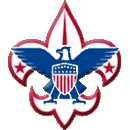| MERIT BADGES |
|
|
|
|
| Note: Eagle Required are in Italics |
"A"
American
Business
American Culture
American Heritage
American Labor
Animal Science
Archaeology
Archery
Architecture
Art
Astronomy
Athletics
Atomic Energy
Auto Mechanics
Aviation
"B"
Backpacking
Basketry
Bird Study
Bugling
"C"
Camping
Canoeing
Chemistry
Cinematography
Citizenship
Community*
Citizenship Nation*
Citizenship World*
Climbing
Coin Collecting
Collections
Communications*
Computers
Cooking
Crime Prevention
Cycling*
"D"
Dentistry
Disability Awareness
Dog Care
Drafting
"E"
Electricity
Electronics
Emergency
Preparedness**
Energy
Engineering
Entrepreneurship
Environmental
Science*
"F"
Family Life*
Farm Mechanics
Fingerprinting
Fire Safety
First Aid*
Fish & Wildlife Mgmt.
Fishing
Fly Fishing
Forestry
"G"
Gardening
Genealogy
Geology
Golf
Graphic Arts
"H"
Hiking
Home Repairs
Horsemanship
"I"
Indian Lore
Insect Studies
"J"
Journalism
"K"
"L"
Landscape Architecture
Law
Leatherwork
Lifesaving**
"M"
Mammal Study
Medicine
Metalwork
Model Design & Building
Motorboating
Music
"N"
Nature
"O"
Oceanography
Orienteering
"P"
Painting
Personal Fitness**
Personal Management*
Pets
Photography
Pioneering
Plant Science
Plumbing
Pottery
Public Health
Public Speaking
Pulp and Paper
"Q"
"R"
Radio
Railroading
Reading
Reptile & Amphibian Study
Rifle Shooting
Rowing
"S"
Safety
Salesmanship
Scholarship
Sculpture
Shotgun Shooting
Skating
Skiing
Small Boat Sailing
Soil & Water
Conservation
Space Exploration
Sports**
Stamp Collecting
Surveying
Swimming**
"T"
Textile
Theatre
Traffic Safety
Truck Transportation
"U"
"V"
Veterinary Medicine
"W"
Water Skiing
Weather
Whitewater
Wilderness Survival
Wood Carving
Woodwork
"X"
"Y"
"Z"
|
|
- Define meteorology. Explain how the weather affects farmers, sailors, aviators, and the outdoors construction industry. Tell why weather forecasts are important to each of these groups.
- Name five dangerous weather-related conditions. Give the safety rules for each when outdoors and explain the difference between a severe weather watch and a warning. Discuss the safety rules with your family.
- Draw cross sections of a cold front and a warm front showing the location and movements of the cold and warm air, the frontal slope, the location and types of clouds associated with the front, and the location of rain. Tell the differences between a cold front and a warm front.
- Tell what causes wind, why it rains, and how lightning and hail are formed. Explain the difference between high and low pressure systems in the atmosphere and tell which is related to good and poor weather.
- Identify and describe clouds in the low, middle, and upper levels of the atmosphere. Relate these to specific types of weather.
- Draw a diagram of the water cycle and label its major processes. Explain the water cycle to your counselor.
- Define acid rain. Identify which human activities pollute the atmosphere as well as the effects such pollution can have on people.
- Do ONE of the following:
- Make one of the following instruments: wind vane, anemometer, rain gauge, hygrometer. Keep a daily weather log for 1 week using information from this instrument as well as from other sources such as local radio and television stations or NOAA Weather Radio. The following information should be recorded at the same time every day: wind direction and speed, temperature, precipitation, and types of clouds. Be sure to make a note of any morning dew or frost. In the log, also list the weather forecasts from radio or television at the same time each day and show how the weather really turned out.
- Visit a National Weather Service office or talk with a local radio or television weathercaster, private meteorologist, local agricultural Extension service office, or university meteorology instructor. Find out what type of weather is most dangerous or damaging to your community. Determine how severe weather and flood warnings reach the homes in your community.
- Do ONE of the following:
- Give a talk of more than 5 minutes to your unit explaining the camping safety rules in the event of lightning, flash floods, and tornadoes. Before your talk, show your outline to your counselor for approval.
- Read several articles about acid rain and give a prepared talk of more than 5 minutes about the articles to your unit. Before your talk, show your outline to your counselor for approval.
|
||||||
Last Update May 15, 2023

.jpg)

 Weather
Weather